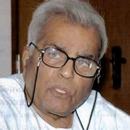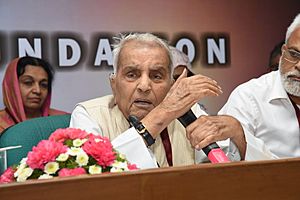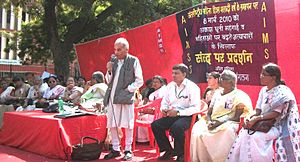Rajinder Sachar facts for kids
Quick facts for kids
Rajindar Sachar
|
|
|---|---|
 |
|
| Born | 22 December 1923 |
| Died | 20 April 2018 (aged 94) Delhi, India
|
| Nationality | Indian |
| Occupation | Lawyer, Judge |
| Known for | Civil rights activity |
Rajindar Sachar (born December 22, 1923 – died April 20, 2018) was an important Indian lawyer and judge. He served as the Chief Justice of the Delhi High Court. He was also a member of a United Nations group that worked to protect human rights. He helped the People's Union for Civil Liberties, a group that stands up for people's rights.
Justice Sachar led the Sachar Committee. This group was set up by the Indian government. They wrote a report about how Muslims in India were doing in terms of their social, economic, and educational lives. In 2011, he was arrested during a protest in New Delhi. This happened when people were protesting the arrest of Anna Hazare and his supporters.
Contents
Early Life and Education
Rajindar Sachar was born on December 22, 1923. His father was Bhim Sen Sachar, who was also a well-known person. His grandfather was a famous lawyer in Lahore. Rajindar Sachar went to the D.A.V. High School in Lahore. After that, he studied at Government College Lahore and Law College, Lahore.
After India and Pakistan became separate countries, Sachar chose to be an Indian citizen. On April 22, 1952, he started working as a lawyer in Shimla. Later, on December 8, 1960, he became a lawyer in the Supreme Court of India. He worked on many different types of legal cases.
In 1963, some politicians left the Indian National Congress party. They formed a new group called the "Prajatantra Party." Sachar helped this group. He helped them prepare documents that accused Pratap Singh Kairon, the Chief Minister of Punjab, India, of corruption. A judge looked into these accusations. In June 1964, the judge found Kairon guilty of several charges.
Becoming a Judge
On February 12, 1970, Rajindar Sachar became an Additional Judge of the Delhi High Court. He was appointed for two years and then for another two years. On July 5, 1972, he became a permanent Judge of the High Court.
He also served as the acting chief justice of the Sikkim High Court. This was from May 16, 1975, to May 10, 1976. Then, he was moved to the Rajasthan High Court. This move happened during a time called The Emergency (1975-1977). During this period, elections and civil liberties were stopped. Sachar was one of the judges who did not agree with the government's actions. Because of this, he was transferred as a form of punishment. After democracy was restored, he was transferred back to the Delhi High Court on July 9, 1977.
In June 1977, the government asked Justice Sachar to lead a committee. This committee looked at laws about companies and trade practices. In August 1978, they gave a big report. Sachar's committee suggested big changes to how companies report their activities. They especially wanted companies to report on their social impact.
In May 1984, Sachar also reviewed the Industrial Disputes Act. He looked at how many cases were waiting to be decided. His report was very strong. He said it was "harsh and unjust" for cases to take years to be decided. He felt the system needed to improve quickly.
In November 1984, Justice Sachar asked the police to act on a petition. This petition was filed by a human rights group. It was based on evidence from victims of the 1984 Sikh riots. The petition asked for cases to be filed against leaders named by the victims. However, the case was moved from his court. It was then heard by two other judges. They asked the petitioners to withdraw their request, but they refused. The petition was then dismissed. Justice Sachar later said he still remembered not being able to get these cases registered.
Sachar was the Chief Justice of the Delhi High Court from August 6, 1985, until he retired on December 22, 1985.
Work After Retirement
Protecting Civil Liberties
After retiring, Justice Sachar continued to work for human rights. He helped write a report in 1990 about the situation in Kashmir. In 1992, he signed an appeal to people in Punjab. It asked them to make sure that upcoming elections were fair and peaceful.
Sachar was also part of an important committee. This group reviewed the Protection of Human Rights Act of 1993. They suggested changes to make the National Human Rights Commission of India stronger. They wanted to reduce delays and broaden the commission's work. These suggestions were given to the government in 2000.
In April 2003, Sachar argued in the Supreme Court of India. He represented the People's Union for Civil Liberties (PUCL). He argued that a law called the Prevention of Terrorist Activities Act (POTA) should be removed. He believed it went against basic human rights. In 2004, he visited people held under POTA who were on a hunger strike. He convinced them to stop. POTA was later removed in November 2004. However, many of its rules were put into another law. In 2009, Sachar called for these laws to be abolished. He said that many innocent people were being held without charges in the name of fighting terror.
Housing Rights
Justice Sachar had worked for the United Nations on the right to proper housing. He led a group that looked into housing rights in Kenya in 2000. Their report said that the Kenyan government was not protecting its citizens' housing rights. It mentioned public land being misused and people being forced out of their homes.
Sachar also took part in an investigation in Mumbai, India. This was about a huge effort to clear slums. Many homes were destroyed, even though there was an order to stop demolitions. Sachar described the scene as "Barbaric, savage." He said it looked "as if a bomb has fallen here." In 2000, he and other judges held hearings about these clearances. About 60,000 people had been forced out of their homes.
In 2002, Sachar led a "People's Court" in Kolkata. This court looked at the problems of people who were being evicted. Their homes were being removed to widen a canal for health and safety. Most of these people were poor workers. The court asked for the affected people to be consulted. It also said they should be treated kindly and not forced out during bad weather.
The Sachar Committee Report
In March 2005, Justice Rajinder Sachar was asked to lead a committee. This committee's job was to study the lives of Muslims in India. They had to prepare a detailed report on their social, economic, and educational situation.
On November 17, 2006, he gave the report to Prime Minister Manmohan Singh. The report showed that Muslims faced growing challenges in India. It found that Muslims, who were over 138 million people in 2001, were not well represented in government jobs, police, or politics. The report also found that Muslims were more likely to be poor, less educated, and have health issues compared to other Indians. It noted that Muslims were sometimes unfairly accused of being against the Indian state.
The Sachar Committee made recommendations to help all communities in India be treated equally. It focused on general ideas rather than specific ones for just one group. This report was a big moment in discussions about Muslims in India. One of its key recommendations was to create an Equal Opportunity Commission. An expert group later prepared a plan for this commission in 2008. However, there was some opposition to the report. Some groups said it was unconstitutional and would divide the country.
Other Activities
In 2003, Sachar challenged the government's plans to privatize two oil companies, Bharat Petroleum and Hindustan Petroleum. He argued that the government could not sell these companies without changing the laws that made them government-owned.
In December 2009, there were reports that Sachar might become the Governor of West Bengal. However, someone else was appointed instead.
Even at the age of eighty-seven, Sachar was arrested by Delhi Police on August 16, 2011. This happened during an India Against Corruption protest. He was arrested for being part of an unlawful gathering and for speaking where protests were not allowed. Sachar said he knew the law and should not be arrested, but he was still taken into custody.
Death
Justice Sachar had heart problems and had a pacemaker. In April 2018, he was admitted to Fortis Hospital in New Delhi. He had vomiting and later got pneumonia. He passed away on April 20, 2018, at the age of 94. His body was cremated at Lodhi Road.




